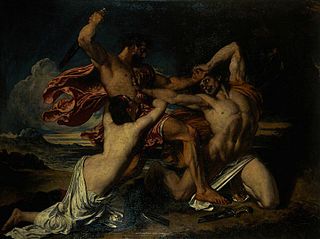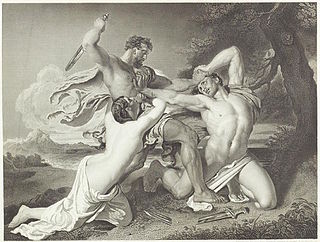
Back مبارزه: زنی که برای شکستخوردگان التماس میکند Persian O Combate: Mulher suplicando pelos Vencidos Portuguese 战斗:为战败者求情的女人 Chinese
The Combat: Woman Pleading for the Vanquished is a large oil painting on canvas by English artist William Etty, first exhibited in 1825 and now in the National Gallery of Scotland. Inspired by the Elgin Marbles and intended by the artist to provide a moral lesson on "the beauty of mercy", it shows a near-nude warrior whose sword has broken, forced to his knees in front of another near-nude soldier who prepares to inflict a killing blow. A woman, also near-nude, clutches the victorious warrior to beg him for mercy. Unusually for a history painting of the period, The Combat does not depict a scene from history, literature or religion and is not based on an existing artwork, but is instead a scene from the artist's own imagination.
When it was shown at the Royal Academy Summer Exhibition of 1825, it attracted near-universal praise from critics for its technical excellence, its fusion of the styles of different schools of painting, and its subject matter. Nevertheless, it failed to find a buyer at the Summer Exhibition, and was instead bought by fellow artist John Martin. The painting proved too large for Martin's house, and in 1831 he sold it on to the Royal Scottish Academy. It was transferred in 1910 to the National Gallery of Scotland, where it remains.

